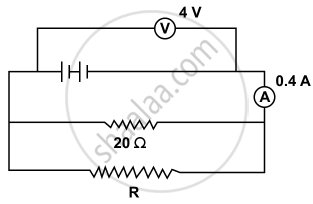Advertisements
Advertisements
Question
In the following figure calculate:
- the total resistance of the circuit
- the value of R, and
- the current flowing in R.

Solution
(a) V = 4 V; I = 0.4 A
Total Resistance R'=?
R' =
(b) R1 = 20 Ω; R' = 10 Ω
R = 20 Ω
(c) R = 20 ohm; V = 4 V
I =
APPEARS IN
RELATED QUESTIONS
Complete the following :-
(b)

How many 176 Ω resistors (in parallel) are required to carry 5 A on a 220 V line?
Explain with diagram what is meant by the "series combination" and "parallel combination" of resistances. In which case the resultant resistance is : (i) less, and (ii) more, than either of the individual resistances?
A resistor has a resistance of 176 ohms. How many of these resistors should be connected in parallel so that their combination draws a current of 5 amperes from a 220 volt supply line?
How will you connect three resistors of 2 Ω, 3 Ω and 5 Ω respectively so as to obtain a resultant of 2.5 Ω? Draw the diagram to show the arrangement.
Four resistors each of resistance 2Ω are connected in parallel. What is the effective resistance?
Explain, why is the p.d. between the terminals of a storage battery less when it is supplying current than when it is on open circuit. A battery of e.m.f. 10 volts and internal resistance 2.5 ohms has two resistances of 50 ohms each connected to it. Calculate the power dissipated in each resistance
(a) When they are in series,
(b) When they are in parallel.
In each case calculate the power dissipated in the battery.
Two resistors of resistance 4 Ω and 6 Ω are connected in parallel to a cell to draw 0.5 A current from the cell.
Draw a labeled diagram of the arrangement
Two resistors of resistance 4 Ω and 6 Ω are connected in parallel to a cell to draw 0.5 A current from the cell.
Calculate current in each resistor.
A particular resistance wire has a resistance of 3·0 ohm per metre. Find the resistance of 5 m length of a wire of the same material, but with twice the area of cross section.
